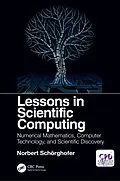Taking an interdisciplinary approach, this new book provides a modern introduction to scientific computing, exploring numerical methods, computer technology, and their interconnections, which are treated with the goal of facilitating scientific research across all disciplines. Each chapter provides an insightful lesson and viewpoints from several subject areas are often compounded within a single chapter. Written with an eye on usefulness, longevity, and breadth, Lessons in Scientific Computing will serve as a "one stop shop" for students taking a unified course in scientific computing, or seeking a single cohesive text spanning multiple courses.
Features:
- Provides a unique combination of numerical analysis, computer programming, and computer hardware in a single text
- Includes essential topics such as numerical methods, approximation theory, parallel computing, algorithms, and examples of computational discoveries in science
- Not wedded to a specific programming language
Autorentext
Norbert Schörghofer is a Senior Scientist at the Planetary Science Institute and lives in Honolulu, Hawaii. After earning degrees in physics from the University of Vienna and the University of Chicago, he held visiting positions at MIT and Caltech, before moving to the University of Hawaii. His research areas are scientific modelling, planetary science, and astrogeophysics. He has published over 60 peer reviewed publications and has been a reviewer for 30 journals. His research has been featured in New Scientist, National Geographic Magazine, Astronomy Magazine, Huffington Post, and other mass media.
Inhalt
Chapter 1. Analytical and Numerical Solutions
Chapter 2. A Few Concepts from Numerical Analysis
Chapter 3. Roundoff and Number Representation
Chapter 4. Programming Languages and Tools
Chapter 5. Sample Problems; Building Conclusions
Chapter 6. Approximation Theory
Chapter 7. Other Common Computational Methods
Chapter 8. Performance Basics and Computer Architectures
Chapter 9. High-Performance and Parallel Computing
Chapter 10. The Operation Count; Numerical Linear Algebra
Chapter 11. Random Numbers and Stochastic Methods
Chapter 12. Algorithms, Data Structures, and Complexity
Chapter 13. Data
Chapter 14. Building Programs for Computation and Data Analysis
Chapter 15. Crash Course on Partial Differential Equiations
Chapter 16. Reformulated Problems
